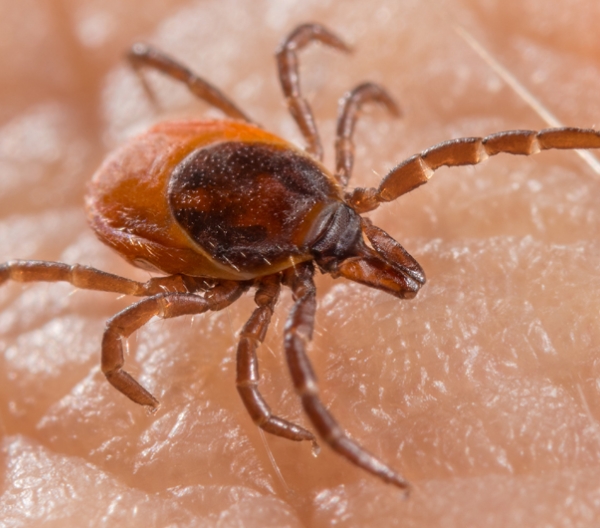What to know about diseases from ticks and mosquitoes
Over the last 20 years, more than a million cases of bug-borne diseases have been reported to the CDC. And that’s only a fraction of how many people were actually infected. Here’s what to know about three of the most common: Lyme disease, tick bite red meat allergy, and West Nile virus.
Enemy territory’s growing
“Ticks are found in every state in the U.S.,” says Bobbi Pritt, a pathologist at the Mayo Clinic. “But they’re not found in every part of every state. For example, they don’t survive well in hot, dry conditions.”
But you’d be hard-pressed to find a mosquito-free zone. They thrive when the humidity tops about 40 percent and temperatures range between 50 and 95 degrees. That’s true for 30 to 60 percent of the year in much of the U.S.
And thanks in part to climate change, mosquitoes and ticks now live where they never did before.
“Climate change influences the survival of ticks because they are more likely to survive over milder winters,” says Pritt.
A warmer and wetter climate also means more mosquitoes. But droughts can also create mosquito-friendly breeding grounds if they lead to more standing water in streams and canals.
“What we’ve been doing to the environment also matters,” Pritt adds. Farmland in the Northeast has been allowed to regrow into young forests, while other forests have been fragmented to build new residential areas.
“Those young forests and little forests in our backyards and parks are very conducive to having lots of mice and deer around,” explains Pritt.
And where you have mice and deer, you have ticks, because they live off the blood of both animals. Mice acquire the bacteria that cause Lyme disease (Borrelia burgdorferi) from infected ticks, who also spread it to other animals...and people.
Lyme disease

Each year, nearly half a million people in the U.S. are diagnosed with Lyme disease, estimates the Centers for Disease Control and Prevention. It’s by far the most common bug-borne disease in the United States. Lyme is most common in the upper Midwest, Northeast, and mid-Atlantic states.
You’re most likely to be bitten by an adult female or a young nymph deer (also called blacklegged) tick. “Nymphs are the most dangerous because they’re about the size of a poppy seed,” says Pritt. “Really tiny, easy to miss.” An adult blacklegged tick is about the size of a sesame seed.
Not all blacklegged ticks are infected with Lyme disease-causing bacteria, and not all infected ticks will transmit the bacteria to you. And even those that do transmit the bacteria don’t do so immediately (though they can swiftly transmit other bacteria, viruses, and parasites).
“It takes about 36 hours while the tick is attached for the bacteria to actually be transmitted to you,” says Pritt. “That’s why it’s important to do tick checks and remove ticks as soon as possible.”
Some good news: “If a tick has been attached for a day or two and it’s engorged, and you’re in an area with Lyme disease, a doctor can prescribe a single dose of the antibiotic doxycycline to prevent Lyme disease,” Pritt explains. (Engorging matters because a flat or unfed tick is unlikely to transmit Lyme.)
What happens if you get Lyme disease? Three to 30 days after being infected, says Pritt, “an estimated 70 to 80 percent of people will get a rash.”
The rash can grow to about 12 inches across and, in many people, it looks like a bullseye. It may be solid red or have blue or purple hues. It’s rarely itchy or painful. Some people get several rashes.
If you have a rash and are in an area where Lyme disease is common, a doctor can prescribe a 10-to-14-day course of antibiotics. People treated with antibiotics early typically recover quickly and completely from Lyme.
But say you don’t see the rash or you never got one. “The early symptoms can include fever, headache, joint pain, or body aches. It can feel like the flu,” says Pritt. “Those nonspecific symptoms can make it rather challenging to diagnose Lyme.”
And there’s no blood test that detects Lyme in its early stages. The blood test for Lyme measures antibodies that your immune system makes to fight the bacteria that cause Lyme, but those antibodies can take a few weeks to form.
“After those first weeks, the tests we have can diagnose most cases,” says Pritt. “A huge focus of our research now is developing a test that works in the first weeks.”
That’s because early detection and treatment are critical. The longer you have Lyme, the worse its consequences.
“Lyme can move into your joints, and you can end up with very swollen, inflamed joints,” notes Pritt. “It can cause inflammation of the heart or brain. You can get something called a facial palsy, where half your face will droop. It can also lead to difficulty concentrating.”
Lyme is harder to treat at that stage. “You can often get rid of the organism by treating it with a longer round of antibiotics, but some of those symptoms may stick around,” says Pritt.
According to the CDC, 5 to 10 percent of people who have been treated for Lyme report ongoing symptoms like fatigue, body aches, and difficulty thinking, a condition referred to as post-treatment Lyme disease syndrome. The cause isn’t clear, though researchers have some ideas.
“One hypothesis is that infection is persistent, though there’s no good evidence to support that,” notes Pritt.
What’s more, in several studies, “people who report having long-term symptoms and are treated with antibiotics for an additional one to three months don’t do any better than people who are not treated with additional antibiotics.”
“Another possibility is that damage has been done by the infection, and you have an ongoing inflammatory condition rather than true infection, similar to what happens to people with long Covid.”
Alternatively, “maybe someone got Lyme but they were also co-infected with another tick-borne virus or parasite that doesn’t respond to the antibiotics that we use to treat Lyme disease,” Pritt suggests. “I think there are some tick-borne diseases that we haven’t yet identified.”
Clearly, researchers have their work cut out for them. Some good news: “A vaccine to prevent Lyme disease is in end-stage clinical trials,” says Pritt. “That’s very encouraging.”

Alpha-gal syndrome
For a growing number of people in the U.S., red meat is off the table, thanks to a bite from the lone star tick.
Alpha-gal syndrome—often called red meat allergy—is caused by the body’s immune response to alpha-gal, a sugar found on the surface of the red blood cells of some mammals, including cows, pigs, and lambs.
Alpha-gal syndrome was first discovered some 15 years ago. Last year, the CDC estimated that there are upwards of 450,000 people in the U.S. living with the relatively newly discovered bug-borne disease.
One theory: Ticks pick up alpha-gal while feeding on mammals like mice and deer, then transfer it to people.
“My read on the evidence is that’s not the main thing at work,” says Jeffrey Wilson, an allergist and immunologist at the University of Virginia School of Medicine.
“Some very well-designed experiments show that some ticks—including the lone star tick—make alpha-gal on their own.”
But a lone star tick bite doesn’t guarantee that you’ll get the allergy.
“In central Virginia, where we are—a hotspot for the lone star tick—about 15 to 20 percent of people test positive for antibodies against alpha-gal,” says Wilson. “But probably 9 out of 10 of those people would not have a reaction to eating red meat.”

To be diagnosed with alpha-gal syndrome, you must have a positive blood test and symptoms like itching, hives, stomach pains, vomiting, swollen lips, or trouble breathing after eating red meat.
But responses to foods containing alpha-gal vary. People with higher blood levels of antibodies to alpha-gal tend to have a stronger allergic reaction.
The dose also matters. “Organ meats like kidney and liver are full of alpha-gal and often result in stronger reactions,” notes Wilson.
Alpha-gal levels in muscle meat (steaks, burgers, bacon, etc.) fall somewhere in the middle range. But very sensitive people may have to even avoid foods with low levels, like dairy or gelatin.
Alpha-gal doesn’t resemble other food allergies. First, food allergies are triggered by proteins, but alpha-gal is a sugar. Second, symptoms appear 2 to 6 hours after eating red meat.
“If you have a peanut or milk allergy and you’re exposed in a restaurant, you usually know you’re in trouble before you leave,” Wilson explains.
“With alpha gal, usually you’re home, tucked in bed, and then you wake up covered in hives or you can’t breathe.”
(An EpiPen works for alpha-gal, like it does for any severe allergic reaction.)
People with alpha-gal syndrome may not have to avoid red meat forever. “Our best evidence suggests that you’re most likely to outgrow alpha-gal syndrome if you can avoid more tick bites,” says Wilson. “And it is more likely to be perpetuated if you get more bites.”
Avoiding ticks may help your immune memory “forget” alpha-gal. “Your immune memory tends to wane over time,” says Wilson.
West Nile virus
West Nile virus—spread by mosquitoes that have bitten infected birds—first made landfall in the United States in 1999 in New York State.
Since then, it has spread to every state (except Alaska and Hawaii) and is the leading cause of mosquito-borne disease in the U.S.
“It’s not unusual to see increases in the number of West Nile virus cases from year to year and in different locations throughout the United States,” says Randall Nett, chief of the CDC’s Arboviral Diseases Branch in the Division of Vector-Borne Diseases.
And outbreaks can pop up in places that aren’t typically mosquito-friendly.
For example, in 2021, Arizona was home to the largest outbreak of West Nile virus in the U.S., when more than 1,100 people became seriously ill and 121 died. (The outbreak accounted for more than half of all cases of severe West Nile illness nationwide that year.)
It’s not clear why, though late-season rain and the construction of new communities in previously wild areas likely contributed.
“Most people infected with West Nile virus don’t feel sick,” says Nett.
“About 1 in 5 will develop a fever with other symptoms such as headache, body aches, vomiting, diarrhea, or rash. Most of them recover completely, but fatigue and weakness can last for weeks or months.”
Then there are the unlucky 1 in 150 people infected with West Nile who get very sick.
“They develop severe illness affecting the central nervous system like encephalitis—inflammation of the brain—or meningitis—inflammation of the membranes that surround the brain and spinal cord,” says Nett.
Some people with severe West Nile illness make a full recovery, but for many, the damage is permanent and life-changing, causing problems like motor dysfunction, memory loss, and depression. Around 10 percent die.
“Severe illness can occur in people of any age,” Nett explains. “But those over 60 are at greater risk.” Ditto for people with cancer, kidney disease, or diabetes, or those who have a suppressed immune system.
Because the symptoms of West Nile are common and can have other causes, the virus can be tricky to recognize. But doctors can diagnose it with a blood or spinal fluid test.
Unfortunately, there’s no treatment for West Nile virus. People with mild symptoms can deal with the virus like they would the flu—with rest, fluids, and over-the-counter pain killers. But those with severe illness often require hospitalization.
So avoiding bites is key. “Prevention of West Nile virus depends on community-level mosquito control programs,” says Nett. “But everyone can play a role in helping protect themselves by using EPA-registered insect repellents and taking other prevention steps.”
Tags
Topics
Continue reading this article with a NutritionAction subscription
Already a subscriber? Log in
The latest on preventing disease
What to know about diseases from ticks and mosquitoes
Preventing Disease

A snapshot of the latest research on diet, exercise, and more
Fact vs. Fiction

How to prevent bites from ticks and mosquitoes
Preventing Disease

Take our quiz to help you stay healthy
Preventing Disease

Colorectal cancer: 5 ways to cut your risk
Preventing Disease


